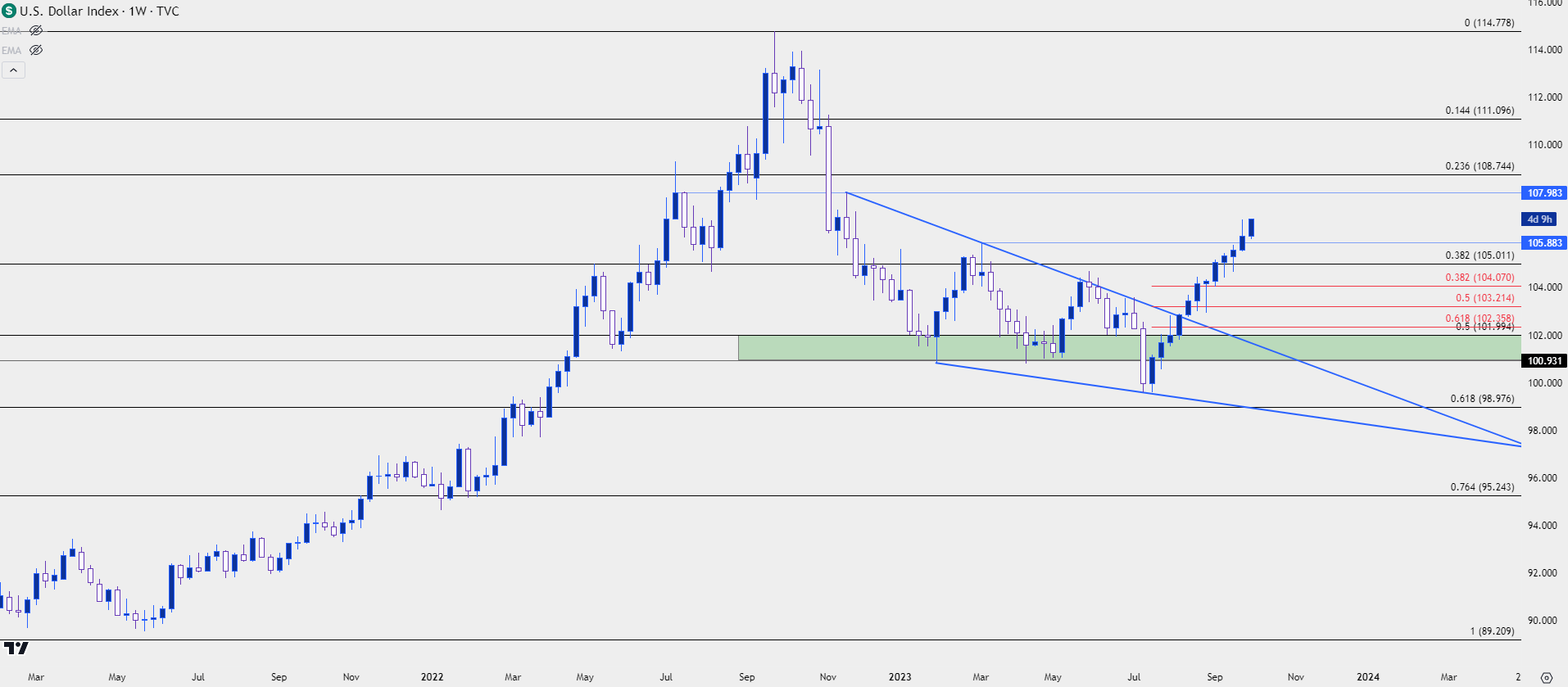
US Dollar Talking Points:
- After consolidation in the first half of the year, USD strength awoke in a big way in Q3 and the USD has gained for each of the past 11 weeks as we move into the Q4 open.
- This is the longest such streak for the USD in a decade and the move has pushed strong trends in several major pairs, with EUR/USD testing the 1.0500 handle and USD/JPY making a move on the same 150 level that helped to form a top in 2022.
- I’ll be discussing these themes in-depth in the weekly webinar on Tuesday at 1PM ET. It’s free for all to register: Click here to register.
The first half of the year was abnormally quiet in many FX pairs and one look at DXY helps to explain why. The Dollar was pushed in a strong rally in 2021 as US inflation showed in a very persistent manner, and this pushed the Fed to policy tightening in 2022, which served to extend those bullish trends in the USD against most other major currencies.
But it was around a year ago when that began to shift and behind the move was a more-hawkish European Central Bank finally addressing their own inflation, coming to the table with 75 bp hikes in September of last year. There was also some assistance from USD/JPY as the Bank of Japan intervened in October of last year which helped to form a top in the pair. And then in November, US inflation started to show more signs of progress in response to all of those prior rate hikes and hope began to build that the Fed may be close to complete with their rate hikes.
That led to a bearish outlay in the DXY for Q4 of last year as those prior trends snapped back. And as we came into Q1 of 2023, FX markets were balancing risk between US inflation which remained high but was punctuated by hope, with higher rates in other economies as they looked to head off their own inflation.
To be sure there were signs of strength along the way, but nothing that bulls could hold on to. In February of this year, a strong NFP report brought back the thought that the Fed may not be done, and there was also the risk that the economy remained too hot despite the ramping of rates in 2022. That led to a bounce in the USD that ran all the way through the March open, but that’s around the time that fears of a banking blowup in the US started to hit rate expectations. This pulled US Treasury rates lower, and the US Dollar fell as driven by the thought that the Fed would not hike the banking sector into further disarray.
That theme of USD-weakness hung around for much of Q2 and as we opened the door to Q3, USD bears took a swing in trying to push the currency to a deeper breakdown, with DXY testing below the 100 level.
But that move could not last and what started as a pullback has since turned into a historically clean run of strength in the DXY with now 11 consecutive weekly gains for the first time since September of 2014. From the monthly chart below, we can see the July breakdown met with failure, highlighted by an extended lower wick, which then ran into strength in August and September.
US Dollar Monthly Price Chart (indicative only, not available on Forex.com platforms)

Chart prepared by James Stanley; data derived from Tradingview
US Dollar Breakout Runs Through Q3 and into Q4
From the weekly chart the US Dollar had built a falling wedge formation before the bullish theme began to price in. Falling wedges are often approached with aim of bullish breakout and that’s precisely what’s shown over the past few months. And when taken in consideration of the prior trend, this keeps the door open for continued strength, driven by the idea that the pullback in the DXY has concluded.
The resistance side of that formation is particularly interesting, as this was in play for a two-week period in late-May and early-June. Bulls failed to drive through at that point, and then when that same trendline came back into play in early-July it led to a harsh breakdown move (which is what failed and led to the bullish reversal).
One of the challenges at the moment is just how strong that trend has been, as there’s been only minor pullbacks in the 11 weeks that this bullish theme has been pricing in. USD has battered through a number of resistance points along the way and this raises the prospect of a deeper pullback if or when that theme does finally appear.
This highlights a number of support levels to incorporate for bullish continuation scenarios. The 105.88 level was the swing high in March and that becomes an item of interest for higher-low support. And a bit deeper, around the 105 psychological level, there’s a confluent Fibonacci level that highlights that as a possible spot of higher-low support if 105.88 cannot hold.
There could even be scope for support at 104.07 or 103.21 given the veracity of the bullish trend, as those levels are the 38.2 and 50% marks from the recent breakout move.
US Dollar Weekly Price Chart (indicative only, not available on Forex.com platforms)

Chart prepared by James Stanley; data derived from Tradingview
--- written by James Stanley, Senior Strategist



